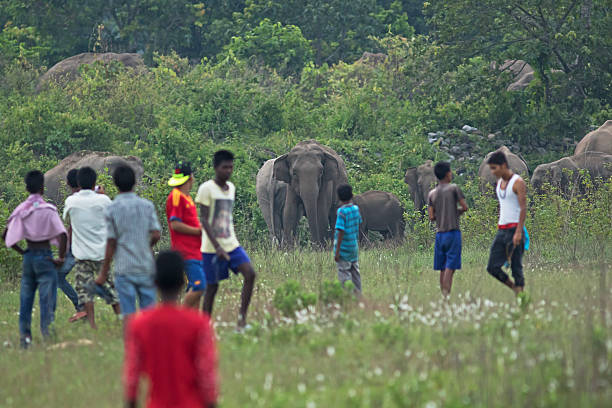Avik Chakraborty
Guwahati, May 4: The human-animal conflict has been rising tremendously in Assam and its neighbouring states due to shrinking forest covers. Assam’s Udalguri district is one of the top human-elephant conflict zones in Assam. Records show more than 100 elephants and 200 people have been killed in the last 12 years in this conflict.
Not just Udalguri, human-animal conflict has been rising in most of the districts in Assam. Deforestation is one of the reason major reasons as forest cover is shrinking day by day and as a result the elephants, leopards and tiger are entering human habitation in search of food.
Humans are entering into forest and encroaching forest land and driving the animals from their area resulting in conflict.
Human – Elephant conflict
According to figures, more than 70 people and 80 pachyderms on average die every year in human-elephant conflict in Assam. As per latest data, 1,330 elephants have died between 2001 and 2022, with the highest number of deaths reported in 2013 when 107 pachyderms died, followed by 97 in 2016 and 92 in 2014.
Among the various reasons for the deaths, 509 died of natural causes, 261 succumbed to unknown reasons, 202 were electrocuted, 102 died in train accidents, 65 due to poisoning, 40 were poached and 18 after being hit by lightning.
The Assam Forest Department data shows that a total of 245 humans and 146 elephants were killed between 2001 and 2014 in man-animal conflict on border between Assam and Bhutan.
“Man-elephant conflict has been rising in Assam due to shrinking of forest covers. The elephant corridors were encroached by humans by building houses on their movement areas. The Bogapani elephant corridor in Digboi, which is known as the longest corridor in Asia, and the Golai elephant corridor has also been affected due to the human encroachment. The elephant movement has been affected and as a result the conflict has been rising,” said Devojit Moran, an environmentalist.
He further added, “The encroachment of natural habitats, fragmentation of forests, and lack of proper management of elephant corridors have led to this conflict. Proper awareness is needed to curb the conflicts which are rising tremendously.”
Meanwhile, the state government has taken various measures to address the issue, including setting up of elephant camps, formation of rapid response teams, and compensation for damages caused by the pachyderm.
According to forest survey of India, Assam lost 65 per cent of its lowland semi-evergreen forests since 1972. All the northeastern states together lost 1802 sq. km. of elephant range habitat between 1991 and 1999.
“The conflict peaks during winter, because the elephants come out of forest in search of food and enter human habitation. Angry villages who want to save their crops from elephant depredation put electric wires and sometimes poison the pachyderms. Due to electrocution, many elephants die every year. To mitigate the human-animal conflict, community participation is necessary,” Bijay Gogoi, a nature activist, said.
Measures such as anti-depredation squad, erection of solar-powered electric fences to prevent elephants from moving towards human habitation, and patrolling to monitor their movement have been undertaken to reduce conflicts in the past years.
Human – Leopard conflict
Human-leopard conflicts are very common nowadays in Assam. In Guwahati, the venturing of leopard in human-settlements are very common. In upper Assam, leopards take refuge in tea garden areas and sometimes they attack workers when they are busy plucking tea leaves.
Recently, leopard attacked two people in upper Assam’s Dibrugarh district. One seven-year-old boy was killed in a leopard attack in Satishpur tea garden in Namrup while another woman was seriously injured in Tamulbari tea estate. She was plucking tea leaves when the leopard attacked her.
Due to shrinking of forest covers, leopards are venturing in human-settlement in search of food and many a times they have taken away pet-dogs and other domestic animals from people’s houses.
Last year in December, 13 people, including three forest personnel, were injured in a leopard attack in upper Assam’s Jorhat district. The incident took place around Rain Forest Research Institute (ICFRE) located at Chenijan.
On March 31, 2023, a leopard was brutally lynched to death in Assam’s Golaghat district and later villagers ate his flesh. The incident had been reported from Tengani in Golaghat’s Barpathar. According to reports, the leopard had attacked a woman.
Human – Rhino conflict
In January 2023, a video of a rhinoceros charging at a safari vehicle carrying tourists in Kaziranga had gone viral. The alarmed tourists could be seen screaming in fear. A month later, a rhinoceros, which had strayed out of the Kaziranga National Park, attacked several people, leaving many of them critically injured.
Last year in December, a 70-year-old man was killed by a rhino in Assam’s Golaghat district. The Rhino chased the person across a paddy filed and killed him.
Rhinos are often seen chasing people and attacking vehicles.
Human – Tiger conflict
Tigers are also often seen venturing in human-settlements, and have been spotted strolling in villages in search of prey.
There are 135 tigers in Kaziranga National Park, 31 in Manas and 21 in Orang. These three reserves are among the 14 in India with accreditation of the Global Conservation Assured/Tiger Standards for meeting the criterion for successful tiger conservation. Today, Kaziranga National Park has India’s second highest destiny of tigers.
The impressive comeback of the species in Assam – from 70 tigers in 2006 to 190 in 2018 – has been marred with an unsettling elephant in the room: increasing human-tiger conflicts and unfair or delayed compensation to local communities living close to the park boundaries.
Community participation is necessary to avoid the conflicts which are rising. The government agencies, NGOs and other nature based organisations need to come forward and generate awareness among the villagers where the conflict has been rising.





